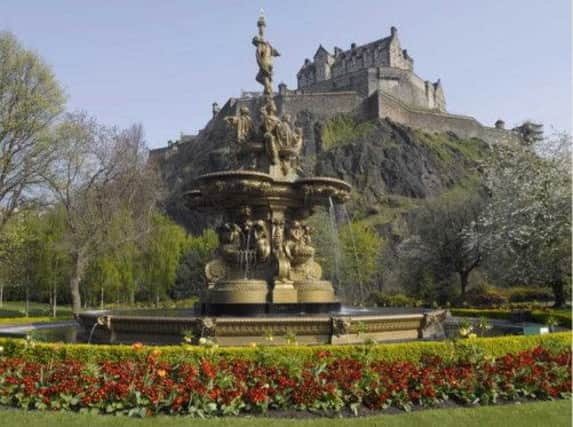Lost Edinburgh: The Ross Fountain
This article contains affiliate links. We may earn a small commission on items purchased through this article, but that does not affect our editorial judgement.


The magnificent Ross Fountain has stood proudly in West Princes Street Gardens for more than 140 years. It is a beautiful and intricately detailed example of 19th century French cast-iron work which features numerous sculptures, including several expertly-crafted female figures depicting science, art, poetry and industry topped by a further female clutching a cornucopia. Its presence in Princes Street Gardens is widely regarded by observers today to considerably enhance the visual impact of the area. Rewind back to the late 1860s however, and we discover that the proposal to install the rather exotic-looking fountain was not universally popular.
The Ross Fountain, minus its curved Craigleith sandstone base, is not Scottish-made and was in fact a creation of the Antoine Durenne iron foundry in Sommevoire, 150 miles south-east of Paris, France. A prototype of the fountain had been commissioned to appear alongside various other Durenne works for the International Exhibition held in London in 1862. One of the visitors to the exhibition was an elderly Edinburgh gun-maker and philanthropist ‘with inclinations to art and natural science’ named Daniel Ross. The fountain had been described as”obtaining universal admiration” and it certainly caught the admiring eye of Mr Ross who decided to purchase it for the princely sum of £2,000 and subsequently gift it to the city of Edinburgh. The fountain was eventually shipped off to Leith in 122 pieces in September 1869. Sadly, the lengthy wrangles between the city authorities and establishment concerning the fountain’s location - and even construction – meant that Mr Daniel Ross would never live to see his incredibly generous and patriotic gift reassembled.
Opposition to the Ross Fountain
Advertisement
Hide AdAdvertisement
Hide AdThe Ross Fountain was finally unveiled to the grateful denizens of Edinburgh in 1872 – a year after the death of its benefactor. Opinion had been severely divided on whether it should be built or not. The fountain’s abundance of sculptures exhibiting naked female flesh, a common feature in Parisian design of the era, was considered quite shocking to a good portion of Edinburgh’s less radical society. One of the most vehemently opposed was the conservative-minded Dean Ramsay, of nearby St. John’s Church, who labelled the nudity-laden structure “Grossly indecent and disgusting; insulting and offensive to the moral feelings of the community and disgraceful to the city”. Mr Daniel Ross had originally requested that his fountain be placed along the upper pathway of the gardens opposite Castle Street, while there were many who preferred other prominent locations such as Charlotte Square, George Street and Lothian Road. It is entirely possible that the presence of multiple bare-breasted and voluptuous ladies pouring water down their chests may have prompted the town council to opt for a more secluded location for the fountain. The Ross Fountain’s eventual site under the imposing shadow of the castle rock appears to be the result of a heavily-debated compromise. It still didn’t please everybody. As a response to the fountain’s erection in the then privately accessed gardens, one passionate objector complained: “I am sorry for the Castle, rock and the garden, and the feelings of any decent-eyed person who cannot avoid seeing this unseemly, and in its present condition nonsensical erection”. Luckily for the future of the fountain, the initial grumbles did eventually die down and it was agreed that the fountain would operate ‘on a sunday and when the band plays’. It is worth mentioning that the naming of the Ross Bandstand is unconnected, though you would be forgiven for failing to believe the coincidence.
Restoration
After undergoing extensive restoration in 2001, the Category B listed Ross Fountain was able to spout water again for the first time in five years. Unfortunately, it has since been bone dry on numerous occasions. According to the latest information it is currently switched off to avoid possible structural damage following years of considerable internal leakage. Despite its rare bouts of operation it is still widely adored and admired by the city’s inhabitants and tourists and the fountain is regularly photographed as an alluring, ornamental foreground subject with Edinburgh Castle positioned directly behind. It must be noted that if not for the kindness of one Victorian gun-maker, Edinburgh’s postcard vendors would be significantly worse off.